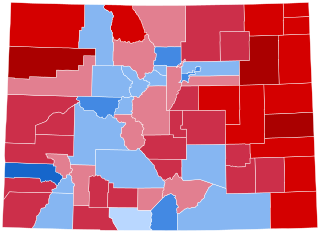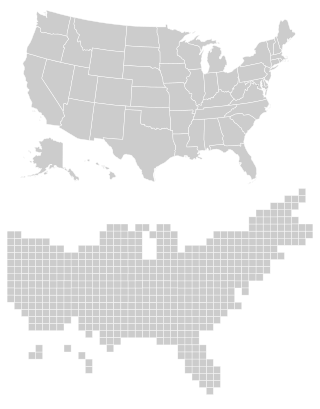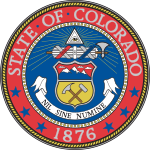
The Twelfth Amendment to the United States Constitution provides the procedure for electing the president and vice president. It replaced the procedure in Article II, Section 1, Clause 3, under which the Electoral College originally functioned. The amendment was proposed by Congress on December 9, 1803, and was ratified by the requisite three-fourths of state legislatures on June 15, 1804. The new rules took effect for the 1804 presidential election and have governed all subsequent presidential elections.

The 1876 United States presidential election was the 23rd quadrennial presidential election, held on Tuesday, November 7, 1876, in which Republican nominee Rutherford B. Hayes faced Democrat Samuel J. Tilden. It was one of the most contentious presidential elections in American history. Its resolution involved negotiations between the Republicans and Democrats, resulting in the Compromise of 1877, and on March 2, 1877, the counting of electoral votes by the House and Senate occurred, confirming Hayes as President. It was the second of five U.S. presidential elections in which the winner did not win a plurality of the national popular vote.

The 1800 United States presidential election was the fourth quadrennial presidential election. It was held from October 31 to December 3, 1800. In what is sometimes called the "Revolution of 1800", the Democratic-Republican Party candidate, Vice President Thomas Jefferson, defeated the Federalist Party candidate, incumbent president John Adams. The election was a political realignment that ushered in a generation of Democratic-Republican leadership. This was the first presidential election in American history to be a rematch.

The Twenty-third Amendment to the United States Constitution extends the right to participate in presidential elections to the District of Columbia. The amendment grants to the district electors in the Electoral College, as though it were a state, though the district can never have more electors than the least-populous state. How the electors are appointed is to be determined by Congress. The Twenty-third Amendment was proposed by the 86th Congress on June 16, 1960; it was ratified by the requisite number of states on March 29, 1961.

In the United States, the Electoral College is the group of presidential electors required by the Constitution to form every 4 years for the sole purpose of appointing the president and vice president. Each state appoints electors under the methods described by its legislature, equal in number to its congressional delegation. The federal District of Columbia also has 3 electors under an amendment adopted in 1961. Federal office holders, including senators and representatives, cannot be electors. Of the current 538 electors, an absolute majority of 270 or more electoral votes is required to elect the president and vice president. If no candidate achieves a majority there, a contingent election is held by the House of Representatives to elect the president and by the Senate to elect the vice president.
In United States presidential elections, an unpledged elector is a person nominated to stand as an elector but who has not pledged to support any particular presidential or vice presidential candidate, and is free to vote for any candidate when elected a member of the Electoral College. Presidential elections are indirect, with voters in each state choosing electors on Election Day in November, and these electors choosing the president and vice president of the United States in December. Electors in practice have since the 19th century almost always agreed in advance to vote for a particular candidate — that is, they are said to have been pledged to that candidate. In several elections in the 20th century, however, competitive campaigns were mounted by candidates who made no pledge to any presidential nominee before the election. These anomalies largely arose from fissures within the Democratic Party over the issues of civil rights and segregation. No serious general election campaign has been mounted to elect unpledged electors in any state since 1964.

In the United States Electoral College, a faithless elector is an elector who does not vote for the candidates for U.S. President and U.S. Vice President for whom the elector had pledged to vote, and instead votes for another person for one or both offices or abstains from voting. As part of United States presidential elections, each state selects the method by which its electors are to be selected, which in modern times has been based on a popular vote in most states, and generally requires its electors to have pledged to vote for the candidates of their party if appointed. A pledged elector is only considered a faithless elector by breaking their pledge; unpledged electors have no pledge to break. The consequences of an elector voting in a way inconsistent with their pledge vary from state to state.

The 2004 United States presidential election in Colorado took place on November 2, 2004, and was part of the 2004 United States presidential election. Voters chose nine representatives, or electors to the Electoral College, who voted for president and vice president.

The National Popular Vote Interstate Compact (NPVIC) is an agreement among a group of U.S. states and the District of Columbia to award all their electoral votes to whichever presidential ticket wins the overall popular vote in the 50 states and the District of Columbia. The compact is designed to ensure that the candidate who receives the most votes nationwide is elected president, and it would come into effect only when it would guarantee that outcome. Introduced in 2006, as of August 2023 it has been adopted by sixteen states and the District of Columbia. These jurisdictions have 205 electoral votes, which is 38% of the Electoral College and 76% of the 270 votes needed to give the compact legal force.
Bills have been introduced in the US Congress on several occasions to amend the US Constitution to abolish or to reduce the power of the Electoral College and to provide for the direct popular election of the US president and vice president.

Electoral reform in Colorado refers to efforts to change the voting laws in the Centennial State.
The president-elect of the United States is the candidate who has presumptively won the United States presidential election and is awaiting inauguration to become the president. There is no explicit indication in the U.S. Constitution as to when that person actually becomes president-elect, although the Twentieth Amendment uses the term "president-elect", thus giving the term "president-elect" constitutional justification. It is assumed the Congressional certification of votes cast by the Electoral College of the United States – occurring after the third day of January following the swearing-in of the new Congress, per provisions of the Twelfth Amendment – unambiguously confirms the successful candidate as the official ‘president-elect’ under the U.S. Constitution. As an unofficial term, president-elect has been used by the media since at least the latter half of the 19th century, and was in use by politicians since at least the 1790s. Politicians and the media have applied the term to the projected winner, even on election night, and very few who turned out to have lost have been referred to as such.

The election of the president and the vice president of the United States is an indirect election in which citizens of the United States who are registered to vote in one of the fifty U.S. states or in Washington, D.C., cast ballots not directly for those offices, but instead for members of the Electoral College. These electors then cast direct votes, known as electoral votes, for president, and for vice president. The candidate who receives an absolute majority of electoral votes is then elected to that office. If no candidate receives an absolute majority of the votes for president, the House of Representatives elects the president; likewise if no one receives an absolute majority of the votes for vice president, then the Senate elects the vice president.
In the United States, a contingent election is used to elect the president or vice president if no candidate receives a majority of the whole number of Electors appointed. A presidential contingent election is decided by a special vote of the United States House of Representatives, while a vice-presidential contingent election is decided by a vote of the United States Senate. During a contingent election in the House, each state delegation votes en bloc to choose the president instead of representatives voting individually. Senators, by contrast, cast votes individually for vice president.

In the 2016 United States presidential election, ten members of the Electoral College voted or attempted to vote for a candidate different from the ones to whom they were pledged. Three of these votes were invalidated under the faithless elector laws of their respective states, and the elector either subsequently voted for the pledged candidate or was replaced by someone who did. Although there had been a combined total of 155 instances of individual electors voting faithlessly prior to 2016 in over two centuries of previous US presidential elections, 2016 was the first election in over a hundred years in which multiple electors worked to alter the result of the election.

The Italian electoral law of 2017, colloquially known by the nickname Rosatellum bis or simply Rosatellum after Ettore Rosato, the Democratic Party (PD) leader in the Chamber of Deputies who first proposed the new law, is a parallel voting system, which acts as a mixed electoral system, with 37% of seats allocated using a first-past-the-post electoral system and 63% using a proportional method, with one round of voting. The Chamber and Senate of the Republic did not differ in the way they allocated the proportional seats, both using the largest remainder method of allocating seats.
Chiafalo v. Washington, 591 U.S. ___ (2020), was a United States Supreme Court case on the issue of "faithless electors" in the Electoral College stemming from the 2016 United States presidential election. The Court ruled unanimously, by a vote of 8–0, that states have the ability to enforce an elector's pledge in presidential elections. Chiafalo deals with electors who received US$1,000 fines for not voting for the nominees of their party in the state of Washington. The case was originally consolidated with Colorado Department of State v. Baca, 591 U.S. ___ (2020), a similar case based on a challenge to a Colorado law providing for the removal and replacement of an elector who does not vote for the presidential candidate who received the most votes in the state, with the electors claiming they have discretion to vote as they choose under the Twelfth Amendment to the United States Constitution. On March 10, 2020, Justice Sonia Sotomayor recused herself in the Colorado case due to a prior relationship to a respondent, and the cases were decided separately on July 6, 2020. Baca was a per curiam decision that followed from the unanimous ruling in Chiafalo against the faithless electors and in favor of the state.
The United States Electoral College was established by the U.S. Constitution, which was adopted in 1789, as part of the process for the indirect election of the President and Vice-President of the United States. The institution has been criticized since its establishment and a number of efforts have been made to reform the way it works or abolish it altogether. Any change would require a constitutional amendment. In 1971, one of these attempts was almost successful in being proposed to the States. An interstate compact proposal, which would bypass the requirement for a constitutional amendment, is at 73% of successful completion as of October 2020.

The Electoral Count Act of 1887 (ECA) is a United States federal law that added to procedures set out in the Constitution of the United States for the counting of electoral votes following a presidential election. In its unamended form, it last governed at the time of the 2021 United States Electoral College vote count. The Act has since been substantially amended by the Electoral Count Reform and Presidential Transition Improvement Act of 2022.












